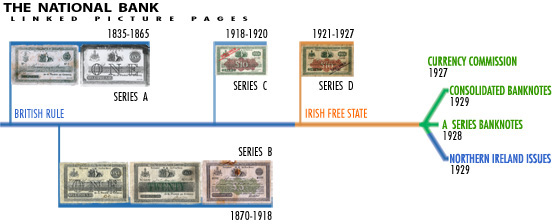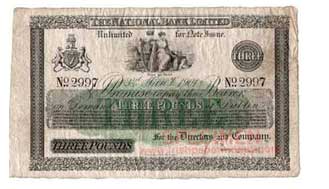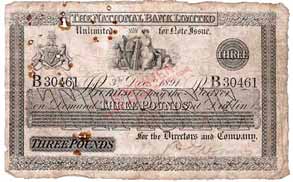

National Bank, Four Series: Series A 1835 - Series B 1870 - Series C 1918 - Series D 1921
Series E, F, Northern Ireland Issue, commencing 1929.
1835-1966
The 1824 Act allowed the creation of Joint Stock banks of note issue in Ireland with the right to issue notes outside of a 50 mile radius of Dublin, with Bank of Ireland retaining a monopoly on note issue within that radius. Prior to this the only joint stock bank in Ireland had been the Bank of Ireland, which had been established as a private joint stock bank by Royal Charter in 1783 and had sole right of note issue for a bank with greater than six partners. All other banks which issued notes were private banks of six partners or less
The National Bank was formed in 1834 in London by Daniel O’Connell and the Nationalist Party as The National Bank of Ireland. The deed of covenant was signed on 6 January 1835 by 249 shareholders. The first Branch opened in Carrick on Suir either on Monday 26 or Wednesday 28 January 1835 (history appears not to have recorded what the exact date was!). The Bank’s first Governor was Daniel O’Connell, a fact which earned the Bank the nickname of The Liberator’s Bank.
The bank aimed itself at farmers and at country business outside Dublin. It expanded its branch network rapidly, but refrained from moving into Ulster to any significant degree as the province was then well covered by the Northern Banking Co., the Belfast Banking Co., and the newer Ulster Banking Co. In 1856 the Bank’s name was changed to The National Bank Ltd., as it commenced business in London.
The National Bank issued its first notes in 1835, and was a large issuer of banknotes. Banknotes of denominations £1, £3, £5, £10, £20, £50, £100 were issued. Of these, no £50 or £100 notes have been recorded except in proof form. Later proof notes are very common, on both pink and white paper, and generally with the bottom third cut off.
Issued notes of the other denominations are obtainable. All denominations are scarce, with £3 and £20 being the rarest. £1 notes are the most common. Issued National Bank notes of any denomination prior to 1900 are rarely offered.
The National Bank issued small size notes with branches (1918-1920) in denominations of £1, £5, £10. It is likely that the issue of the £3 denomination was discontinued after 1915, the last year for which a note has been seen.
Small size notes without branches (1921-1926) were produced in all denominations up to £100. The National Bank was the only bank to issue the full range of denominations as small size notes in this era. It is likely that £20, £50 and £100 notes circulated in small quantities, though they have only been seen as Specimen notes.
It issued Consolidated Banknotes in 1929, as well as its own Northern Ireland issue.
In 1966 the Irish Business of the Bank was taken over by a new company called The National Bank of Ireland Ltd., which was set up as a subsidiary of The Bank of Ireland Group. The National Bank was subsequently taken over by the Bank of Ireland.


Irish Joint Stock Banks of Note Issue from 1783
Contemporary Forgeries of Early Irish Banknotes ca1800-1930
Irish Three Pound Notes of the Joint Stock Banks
The Transition of Irish Currency, Irish banknotes 1918–1928
The Partition of Irish currency, Irish banknotes 1928–1930